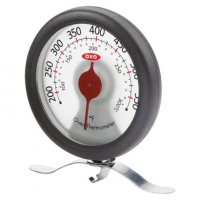 Most baking recipes call for “preheating the oven before baking.” But, what does that mean? And, how can you tell if your oven is accurate?
Most baking recipes call for “preheating the oven before baking.” But, what does that mean? And, how can you tell if your oven is accurate?
Typically preheat you oven for for a minimum of 20 minutes before baking, unless specified by the recipe, usually for bread recipes, which require slightly longer times to make sure the oven gets really hot, or for pizza baking to ensure the pizza stone gets sizzling hot before baking on it.
One of the most common baking problems are caused by inaccurate ovens. Cakes will fall or become lopsided, cookies will burn on the outside but will remain undone in their centers, cheesecakes will not set properly or will crack from too much heat, or your breads will remain gummy on the inside, taking forever to bake, or burn quickly on their crusts, becoming dry and inedible inside.
SARAH SAYS: Other keys to baking accuracy and success, are to not overcrowd your oven during baking, so the hot air can circulate around your recipe; Do not open the oven door to check on your baked good until the minimum time suggested in the recipe for doneness; When you open the oven door, open it slightly to check on your recipe – do not open it fully, and avoid pulling out the shelf to check your recipe for doneness.
To make sure your oven is calibrated accurately, here are a few of my tips:
TEST YOUR OVEN FOR ACCURACY
THE QUICK WAY: Bake a boxed cake mix to test your oven for accuracy.
Make and bake one layer from a boxed cake mix, placed in the middle of the middle oven shelf. Measure how long it takes to bake. Does it bake faster or slower than the suggested time on the box? Yes, ovens do vary, but if your cake's baking time is so far off the mark, something is wrong. Cakes made from boxed mixes are tested in multiple oven brands by the cake mix manufacturer, and their baking times are completely accurate for consumers.
THE MORE ACCURATE WAY: Use an oven thermometer to test your oven for temperature accuracy (and repeat this test every 6 months because your oven can go out of temperature at any time):
1. Get two oven thermometers, and replace them ever year. They become fatigued over time, or break, so you will need to get new ones to ensure that your oven's temperature stays accurate.
2. Test:
a. Place one thermometer in the middle of the middle oven shelf so it is visible through the oven window;
b. Turn on the oven to 350 degrees F, preheat the oven, and take a temperature reading without opening the oven door;
c. Take three more temperature readings every 20 minutes without opening the oven door;
d. When you have four readings, calculate their average by adding and then dividing them by four. If the average is between 325 degrees F and 375 degrees F, your oven is accurate and calibrated. If it’s outside that range, the oven needs adjustment from a professional.
3. For ongoing baking, use two oven thermometers. Place one each at both sides of the middle oven shelf, making sure you do not touch the walls of the oven.
Ovens tend to have hot spots, especially near the walls of your oven (side to side, front to back, and top to bottom). Your thermometers will help keep track of these hot spot temperatures so you can avoid them, and gauge their temperatures. You also want to make sure the air in your oven is circulating properly along its walls for even baking.


